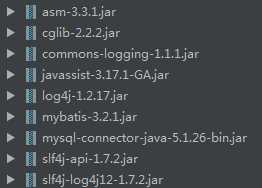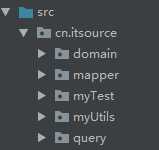Mybatis使用步骤
Posted tuxiaoer
tags:
篇首语:本文由小常识网(cha138.com)小编为大家整理,主要介绍了Mybatis使用步骤相关的知识,希望对你有一定的参考价值。
一:导包

二、配置相关的xml文件 -- mybatis-config.xml
<?xml version="1.0" encoding="UTF-8" ?>
<!DOCTYPE configuration PUBLIC "-//mybatis.org//DTD Config 3.0//EN"
"http://mybatis.org/dtd/mybatis-3-config.dtd">
<configuration>
<!--加载数据库的配置文件,jdbc.properties文件是在项目的resources文件夹下-->
<properties resource="jdbc.properties"></properties>
<!--取别名,type属性的值是类的权限定名-->
<typeAliases>
<typeAlias type="cn.itsource.domain.Employee" alias="employee"></typeAlias>
<typeAlias type="cn.itsource.query.EmployeeQuery" alias="employeeQuery"></typeAlias>
</typeAliases>
<!--配置数据库的信息-->
<environments default="mysql">
<environment id="mysql">
<transactionManager type="JDBC"></transactionManager>
<dataSource type="POOLED">
<property name="username" value="$username"/>
<property name="password" value="$password"/>
<property name="url" value="$url"/>
<property name="driver" value="$driverClassName"/>
</dataSource>
</environment>
</environments>
<!--domain类对应的xml-->
<mappers>
<mapper resource="cn/itsource/mapper/EmployeeMapper.xml"></mapper>
</mappers>
</configuration>
三、 domain层建表
public class Employee
private Long id;
private String username;
private String password;
private Integer sex;
private Integer age;
此处省略set/get方法
四、准备mapper层(相当于以前的dao层)
注意:方法名必须和EmployeeMapper.xml文件中配置的方法名必须一致
public interface EmployeeMapper
//查询所有
List<Employee> findAll();
//高级查询
List<Employee> findByQuery(EmployeeQuery query);
//添加一个
void save(Employee employee);
//批量添加-使用数组方式
void batchSaveByArray(Employee[] array);
//批量添加-使用集合的方式
void batchSaveByList(List<Employee> list);
五、涉及到高级查询,就先准备一个高级查询的类,query层建一个EmployeeQuery高级查询类

public class EmployeeQuery
private String username;//用户名
private Integer sex;//性别
private Integer minAge;//最小年龄
private Integer maxAge;//最大年龄
省略set/get方法
六、配置EmployeeMapper.xml文件(文件暂时放在mapper层)
<?xml version="1.0" encoding="UTF-8" ?>
<!DOCTYPE mapper PUBLIC "-//mybatis.org//DTD Mapper 3.0//EN"
"http://mybatis.org/dtd/mybatis-3-mapper.dtd">
<mapper namespace="cn.itsource.mapper.EmployeeMapper">
<!--
抽取公共的SQL语句,每次写字段的时候都比较麻烦,所以就直接抽取出来了,用<sql>标签抽取,id名字任意取
取值的时候用</include>标签取值
-->
<sql id="colum">
(username,password,sex,age)
</sql>
<sql id="parme">
(#username,#password,#sex,#age)
</sql>
<!-- 查询方法用<select>,新增用<insert>,修改用<update> -->
<!--查询所有:
id属性对应的值,必须和EmployeeMapper接口中的方法名一致,
resultType:返回值类型,要将查询结果封装到Employee这个类中,再装入集合里面返回,我这里使用的是别名,因为在mybatis-config.xml文件中配置了别名,
不涉及到参数,所以这里就没有添加参数类型
-->
<select id="findAll" resultType="employee">
select * from w_employee;
</select>
<!--高级查询:
parameterType:参数类型,高级查询专门准备了一个查询的条件的类
<if test="判断条件"> 满足条件要执行的内容,这里就只是拼接SQL语句</if> :xml的条件标签,
<where>标签:会把标签里面的条件的第一个and 改成where,所以<if>标签里面满足条件的SQL语句都使用and连接
注意:在xml中<(小于符号是一个特殊符号),默认是标签开始符,但是这里要判断年龄小于等于最大年龄,有2中解决方式,第一种忘记了,
就记得第二种使用<![CDATA [ 这里的内容不会被xml解析 ] ]>
-->
<select id="findByQuery" parameterType="employeeQuery" resultType="employee">
select * from w_employee
<where>
<if test="username!=null and username!=‘‘" >
and username like concat("%",#username,"%")
</if>
<if test="minAge!=null">
and age>=#minAge
</if>
<if test="maxAge!=null">
and <![CDATA[age<=#maxAge]]>
</if>
</where>
</select>
<!--单个保存:
useGeneratedKeys="true" keyColumn="id" keyProperty="id"
以上配置是在一个方法里面做保存的时候,就可以拿到刚保存的数据的id,以前是必须要方法完成并保存到数据库才能获取到id,
在做关系保存是有用,一个方法里同时保存一方和多方,先保存一方,获取到一方的id,再保存多方。
-->
<insert id="save" useGeneratedKeys="true" keyColumn="id" keyProperty="id" parameterType="employee">
insert into w_employee <include refid="colum"></include>
values <include refid="parme"></include>
</insert>
<!--
<include refid="colum"/>:引用<sql>标签中的数据,
<foreach.> 循环标签, collection:指定类型进行循环,一般是数组和集合, 数组:参数类型就需要使用Object[]或者Object----parameterType="Object";
集合:参数类型就是list(小写)